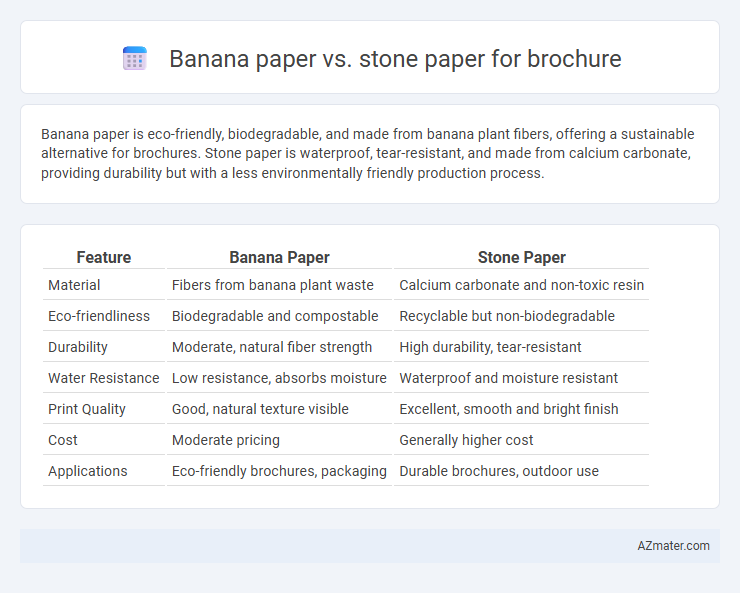Banana paper is eco-friendly, biodegradable, and made from banana plant fibers, offering a sustainable alternative for brochures. Stone paper is waterproof, tear-resistant, and made from calcium carbonate, providing durability but with a less environmentally friendly production process.
Table of Comparison
| Feature | Banana Paper | Stone Paper |
|---|---|---|
| Material | Fibers from banana plant waste | Calcium carbonate and non-toxic resin |
| Eco-friendliness | Biodegradable and compostable | Recyclable but non-biodegradable |
| Durability | Moderate, natural fiber strength | High durability, tear-resistant |
| Water Resistance | Low resistance, absorbs moisture | Waterproof and moisture resistant |
| Print Quality | Good, natural texture visible | Excellent, smooth and bright finish |
| Cost | Moderate pricing | Generally higher cost |
| Applications | Eco-friendly brochures, packaging | Durable brochures, outdoor use |
Introduction to Sustainable Paper Alternatives
Banana paper, made from agricultural waste such as banana stems, offers a biodegradable and eco-friendly alternative to traditional paper, reducing deforestation and waste accumulation. Stone paper, composed of calcium carbonate bonded with non-toxic resin, provides a durable, water-resistant, and tree-free option that minimizes water and chemical usage during production. Both materials present sustainable solutions for brochure printing, aligning with growing environmental concerns and the demand for greener paper alternatives.
What is Banana Paper?
Banana paper is an eco-friendly material made from the fibers of banana plants, offering a sustainable alternative to traditional paper products. Unlike stone paper, which is composed of calcium carbonate and resin, banana paper is biodegradable, recyclable, and supports agricultural waste recycling by utilizing banana stems often discarded after harvest. This natural composition provides a unique texture ideal for brochures seeking an environmentally responsible and tactile printing solution.
What is Stone Paper?
Stone paper is a sustainable, eco-friendly material made from calcium carbonate bonded with non-toxic resin, offering waterproof and tear-resistant qualities ideal for brochures. Unlike traditional banana paper derived from agricultural waste fibers, stone paper provides a smooth, matte finish that enhances print quality and durability. Its chemical-free production reduces environmental impact, making it a preferred choice for businesses seeking long-lasting, recyclable brochure options.
Environmental Impact: Banana Paper vs Stone Paper
Banana paper, made from agricultural waste like banana stems, offers a highly sustainable option by reducing reliance on wood pulp and minimizing deforestation. Stone paper, composed primarily of calcium carbonate and non-toxic resins, eliminates water and tree use during production but involves higher energy consumption and is less biodegradable. Evaluating environmental impact, banana paper provides superior biodegradability and lower carbon footprint, while stone paper's durability and plastic resistance present a unique trade-off in ecological considerations.
Production Process Comparison
Banana paper production involves recycling banana plant fibers, which are soaked, beaten into pulp, and dried into sheets, offering an eco-friendly alternative with natural fiber strength. Stone paper is made from calcium carbonate bonded with non-toxic resin, requiring no water or trees, resulting in a waterproof, durable material through extrusion and calendaring processes. Comparing both, banana paper relies on agricultural waste and traditional pulp methods, while stone paper uses mineral resources with a plastic-like manufacturing approach, impacting eco-footprints differently.
Print Quality and Texture Differences
Banana paper exhibits a natural, fibrous texture that enhances print quality with a rustic, organic look ideal for eco-conscious brochures, while stone paper offers a smooth, matte surface delivering sharp, vibrant images with high detail retention. The porous nature of banana paper can cause slight ink absorption variations, adding character but reducing crispness in fine details compared to the consistent ink adherence on stone paper. Stone paper's waterproof and tear-resistant properties make it suitable for durable brochures requiring a premium, silky finish, contrasting with the biodegradable and artisanal appeal of banana paper.
Durability and Water Resistance
Banana paper offers moderate durability and water resistance due to its natural fiber composition, making it eco-friendly but less resistant to prolonged moisture exposure. Stone paper, made from calcium carbonate and resin, provides superior durability with excellent water resistance, preventing tearing and swelling in wet conditions. For brochures requiring high resilience and waterproof qualities, stone paper outperforms banana paper in maintaining structural integrity and aesthetic appeal.
Cost and Availability
Banana paper generally offers a lower cost per unit compared to stone paper, making it more budget-friendly for brochure printing, especially in bulk orders. Availability of banana paper is somewhat region-dependent, with higher accessibility in countries producing banana agriculture waste, while stone paper boasts wider global distribution due to its mineral-based composition. Both materials provide durable alternatives to traditional paper, but cost efficiency and local sourcing advantages often make banana paper a preferred choice for eco-conscious businesses aiming to reduce printing expenses.
Suitability for Brochure Printing
Banana paper offers a sustainable and biodegradable option with a unique texture that enhances eco-friendly brochure branding, while its natural fibers provide moderate durability and print clarity suitable for short to medium-run printing. Stone paper, made from calcium carbonate, delivers a smoother, waterproof, and tear-resistant surface ideal for high-quality, long-lasting brochures that endure handling and moisture exposure. Both materials differ significantly in environmental impact and tactile appeal, influencing their suitability based on brochure purpose and desired consumer experience.
Choosing the Right Eco-Friendly Paper
Banana paper, made from banana plant fibers, offers a biodegradable and sustainable alternative with a natural texture ideal for eco-conscious brochures. Stone paper, composed of calcium carbonate and resin, provides water-resistant, tear-proof qualities but is less biodegradable despite being recyclable. Selecting the right eco-friendly paper depends on balancing durability, environmental impact, and the message your brochure aims to convey.

Infographic: Banana paper vs Stone paper for Brochure
 azmater.com
azmater.com